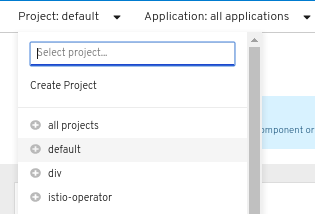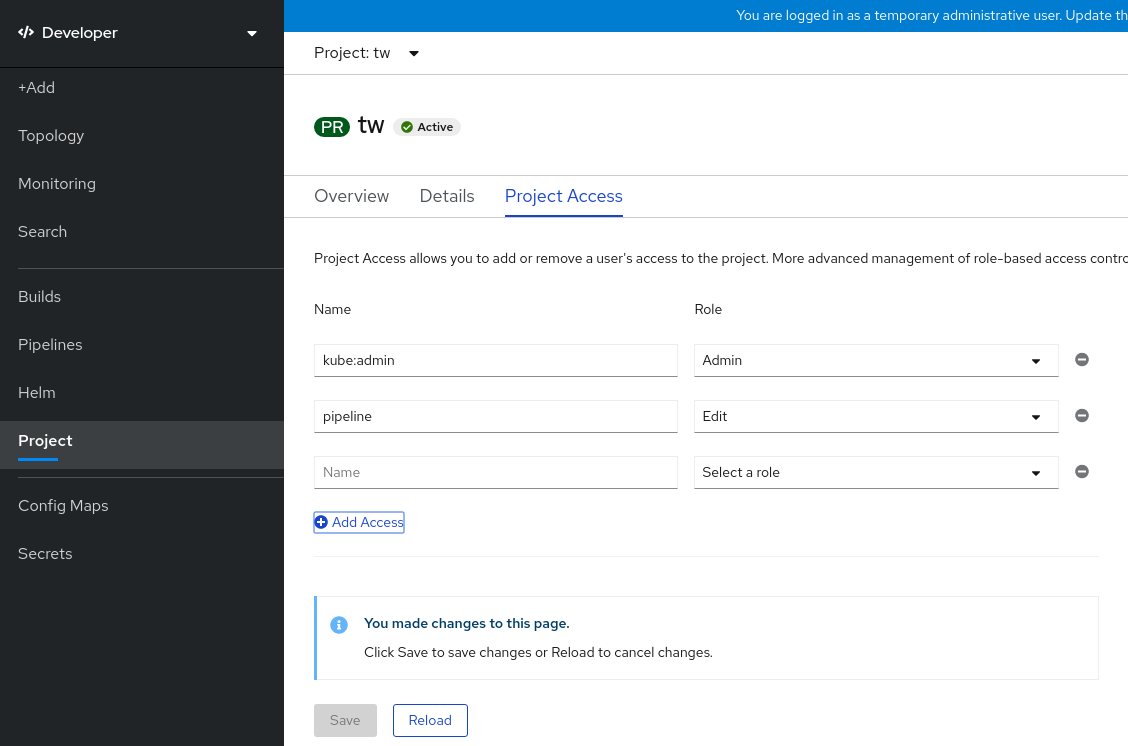This documentation is for a release that is no longer maintained
See documentation for the latest supported version 3 or the latest supported version 4.第 1 章 Projects
1.1. Working with projects
A project allows a community of users to organize and manage their content in isolation from other communities.
Projects starting with openshift- and kube- are default projects. These projects host cluster components that run as pods and other infrastructure components. As such, OpenShift Container Platform does not allow you to create projects starting with openshift- or kube- using the oc new-project command. Cluster administrators can create these projects using the oc adm new-project command.
You cannot assign an SCC to pods created in one of the default namespaces: default, kube-system, kube-public, openshift-node, openshift-infra, and openshift. You cannot use these namespaces for running pods or services.
1.1.1. Creating a project using the web console
If allowed by your cluster administrator, you can create a new project.
Projects starting with openshift- and kube- are considered critical by OpenShift Container Platform. As such, OpenShift Container Platform does not allow you to create Projects starting with openshift- using the web console.
You cannot assign an SCC to pods created in one of the default namespaces: default, kube-system, kube-public, openshift-node, openshift-infra, and openshift. You cannot use these namespaces for running pods or services.
Procedure
-
Navigate to Home
Projects. - Click Create Project.
- Enter your project details.
- Click Create.
You can use the Developer perspective in the OpenShift Container Platform web console to create a project in your cluster.
Projects starting with openshift- and kube- are considered critical by OpenShift Container Platform. As such, OpenShift Container Platform does not allow you to create projects starting with openshift- or kube- using the Developer perspective. Cluster administrators can create these projects using the oc adm new-project command.
You cannot assign an SCC to pods created in one of the default namespaces: default, kube-system, kube-public, openshift-node, openshift-infra, and openshift. You cannot use these namespaces for running pods or services.
Prerequisites
- Ensure that you have the appropriate roles and permissions to create projects, applications, and other workloads in OpenShift Container Platform.
Procedure
You can create a project using the Developer perspective, as follows:
Click the Project drop-down menu to see a list of all available projects. Select Create Project.
图 1.1. Create project
-
In the Create Project dialog box, enter a unique name, such as
myproject, in the Name field. - Optional: Add the Display Name and Description details for the project.
- Click Create.
- Use the left navigation panel to navigate to the Project view and see the dashboard for your project.
Optional:
- Use the Project drop-down menu at the top of the screen and select all projects to list all of the projects in your cluster.
- Use the Details tab to see the project details.
- If you have adequate permissions for a project, you can use the Project Access tab to provide or revoke administrator, edit, and view privileges for the project.
1.1.3. Creating a project using the CLI
If allowed by your cluster administrator, you can create a new project.
Projects starting with openshift- and kube- are considered critical by OpenShift Container Platform. As such, OpenShift Container Platform does not allow you to create Projects starting with openshift- or kube- using the oc new-project command. Cluster administrators can create these Projects using the oc adm new-project command.
You cannot assign an SCC to pods created in one of the default namespaces: default, kube-system, kube-public, openshift-node, openshift-infra, and openshift. You cannot use these namespaces for running pods or services.
Procedure
- Run:
oc new-project <project_name> \
--description="<description>" --display-name="<display_name>"
$ oc new-project <project_name> \
--description="<description>" --display-name="<display_name>"For example:
oc new-project hello-openshift \
--description="This is an example project" \
--display-name="Hello OpenShift"
$ oc new-project hello-openshift \
--description="This is an example project" \
--display-name="Hello OpenShift"The number of projects you are allowed to create may be limited by the system administrator. After your limit is reached, you might have to delete an existing project in order to create a new one.
1.1.4. Viewing a project using the web console
Procedure
-
Navigate to Home
Projects. Select a project to view.
On this page, click the Workloads button to see workloads in the project.
1.1.5. Viewing a project using the CLI
When viewing projects, you are restricted to seeing only the projects you have access to view based on the authorization policy.
Procedure
To view a list of projects, run:
oc get projects
$ oc get projectsCopy to Clipboard Copied! Toggle word wrap Toggle overflow You can change from the current project to a different project for CLI operations. The specified project is then used in all subsequent operations that manipulate project-scoped content:
oc project <project_name>
$ oc project <project_name>Copy to Clipboard Copied! Toggle word wrap Toggle overflow
You can use the Project view in the Developer perspective to grant or revoke access permissions to your project.
Procedure
To add users to your project and provide Admin, Edit, or View access to them:
- In the Developer perspective, navigate to the Project view.
- In the Project page, select the Project Access tab.
Click Add Access to add a new row of permissions to the default ones.
图 1.2. Project permissions
- Enter the user name, click the Select a role drop-down list, and select an appropriate role.
- Click Save to add the new permissions.
You can also use:
- The Select a role drop-down list, to modify the access permissions of an existing user.
- The Remove Access icon, to completely remove the access permissions of an existing user to the project.
Advanced role-based access control is managed in the Roles and Roles Binding views in the Administrator perspective.
1.1.7. Adding to a project
Procedure
- Select Developer from the context selector at the top of the web console navigation menu.
- Click +Add
- At the top of the page, select the name of the project that you want to add to.
- Click on a method for adding to your project, and then follow the workflow.
1.1.8. Checking project status using the web console
Procedure
-
Navigate to Home
Projects. - Select a project to see its status.
1.1.9. Checking project status using the CLI
Procedure
Run:
oc status
$ oc statusCopy to Clipboard Copied! Toggle word wrap Toggle overflow This command provides a high-level overview of the current project, with its components and their relationships.
1.1.10. Deleting a project using the web console
You can delete a project by using the OpenShift Container Platform web console.
If you do not have permissions to delete the project, the Delete Project option is not available.
Procedure
-
Navigate to Home
Projects. - Locate the project that you want to delete from the list of projects.
-
On the far right side of the project listing, select Delete Project from the Options menu
 .
.
- When the Delete Project pane opens, enter the name of the project that you want to delete in the field.
- Click Delete.
1.1.11. Deleting a project using the CLI
When you delete a project, the server updates the project status to Terminating from Active. Then, the server clears all content from a project that is in the Terminating state before finally removing the project. While a project is in Terminating status, you cannot add new content to the project. Projects can be deleted from the CLI or the web console.
Procedure
Run:
oc delete project <project_name>
$ oc delete project <project_name>Copy to Clipboard Copied! Toggle word wrap Toggle overflow

